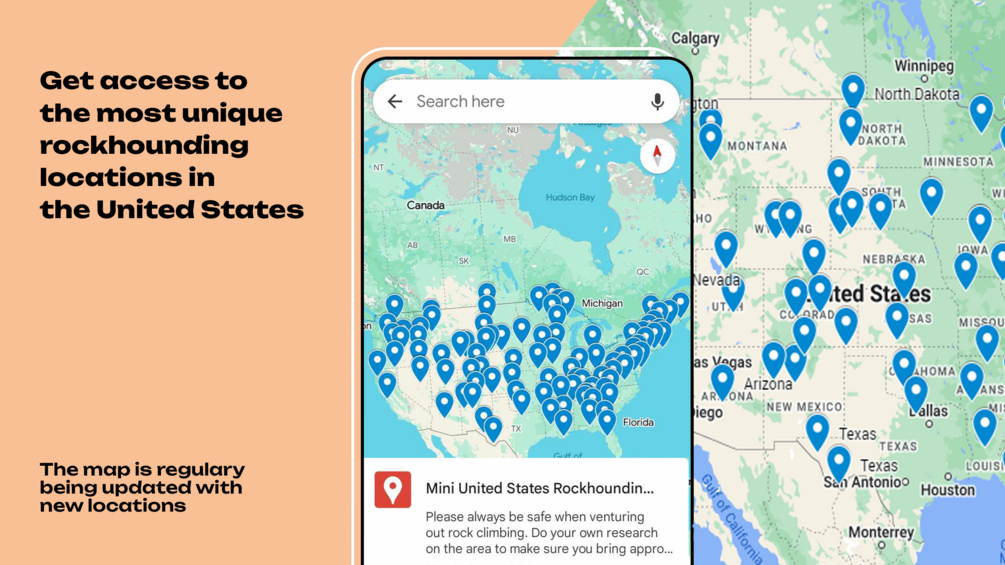Maine, known as the Pine Tree State, isn’t just famous for its scenic coastlines and delicious lobsters—it’s also a treasure trove for rockhounds.
With its unique geology, you’re in for a real adventure as you explore its diverse rockhounding sites. From the rugged beaches to the remote mountains, Maine offers an array of locations where you can unearth some truly remarkable gems and minerals.
As you gear up for your next rockhounding excursion, you’ll be thrilled to discover what Maine has hidden beneath its surface. Whether you’re an amateur or a seasoned collector, you’ll find plenty to satisfy your curiosity. Get ready to dig into the rich mining history and uncover everything from tourmaline to amethyst.
Let’s dive into where you should go and what dazzling finds await you in Maine’s great outdoors.
Maine offers diverse rockhounding experiences, with Western Maine known for tourmaline and quartz, coastal regions for polished granite and unique beach stones, and the Central to Northern areas for basalt flows, limestone quarries, zeolites, agates, and fossils.
Get our FREE United States Rockhounding Map HERE

Maine Rockhounding Locations
As you venture into the rocky terrains of Maine, you’ll discover that the state’s vast landscapes offer numerous rockhounding spots, each boasting a unique set of minerals and gemstones.
Western Maine: A Haven for Gemstones
In Western Maine, the mountainous regions, particularly in Oxford County, are renowned for their gemstone deposits. Here, you’re likely to encounter:
- Tourmaline: Maine’s state mineral comes in a rainbow of colors, each captivating in its way.
- Quartz varieties: From smoky quartz to rose quartz, these crystals are abundant in the area.
Dig Maine Gems in Bryant Pond, for instance, lets you sift through piles rich with mineral treasures. If you like the comfort of certainty, the convenience of pay-to-dig sites like Mt. Mica Mine offers an authentic opportunity to unearth local gems.
Coastal Regions: A Trove of Geological Wonders
Moving towards Maine’s coast, your rockhounding adventure will take a different turn. The coastline, marked by its historic significance, is a playground for finding geological fragments from a bygone era. Notably, the area around Deer Isle is reputable for its:
- Polished granite: Used in construction and sculpture.
- Unique beach stones: Often sought after for their aesthetic value and smooth textures.
Central to Northern Maine: Exploring the Lesser Known
Perhaps lesser frequented by hobbyists yet equally rewarding are Central and Northern Maine. The terrain here is riddled with:
- Basalt flows: Source of zeolite and agates.
- Limestone quarries: Deposit sites for fossils, offering you a lens into ancient marine life.
While Aroostook County offers expansive fields that may require more effort to scour, the solitude is often rewarded with finds untouched by the masses. It’s the peace and thrill of discovery that beckons true enthusiasts to these grounds.
What Gemstones are Found in Maine?

Maine’s diverse geology sets the stage for a multifaceted gem-hunting experience. You’re likely to encounter a variety of precious stones, each with its own unique allure. The state’s reputation spikes particularly for tourmaline, especially in Western Maine. Tourmaline comes in a spectrum of colors, and Maine’s varieties are renowned for their high quality.
But the gemstone finds don’t end there. Embark on a treasure quest for aquamarine, a blue to greenish-blue gem, best located in pockets of granite throughout the state. Amethyst, with its captivating purple hues, can be discovered in Oxford County, bringing a royal essence to your collection.
In addition, Maine provides prime opportunities for finding topaz and garnet. These stones, though more elusive, reward dedicated searchers with their beauty and rarity. Here’s a glimpse at some of the coveted gemstones you might uncover:
- Tourmaline (Black, Green, Pink)
- Aquamarine
- Amethyst
- Topaz
- Garnet
As you explore, it’s important to respect private land and adhere to local regulations. Public lands and designated rockhounding sites often yield the best results and let you search without worry.
Field techniques are crucial to your success. Familiarize yourself with what raw gemstones look like and the type of terrain they’re typically found in. Maine’s gemstones mostly occur in pegmatites, a type of igneous rock laden with sizeable crystal formations. This makes sites with exposed bedrock or old quarries prime spots for your search. With patience and a bit of luck, you’ll add these natural treasures to your collection, and maybe discover some unexpected finds along the way.
What Sedimentary Rocks You Can Find in Maine?

While Maine is famous for its stunning gemstones, your rockhounding adventure wouldn’t be complete without exploring the variety of sedimentary rocks the state offers. You’ll discover that sedimentary rocks are not as prevalent as metamorphic or igneous rocks in Maine, but there are certain areas where you can find these geological treasures.
Sandstone and shale are the most common sedimentary rocks you’ll encounter in Maine. These rocks are typically found in layers, with shale being identified by its fine-grained texture and tendency to split into thin sheets. On the other hand, sandstone, known for its gritty texture, often appears in a range of colors from light beige to reddish hues, depending on the iron oxide content.
You might also stumble upon limestone in your searches. This sedimentary rock, formed mainly from the skeletal fragments of marine organisms, can be spotted in various locations throughout the state, especially in lowlands and valleys where ancient seas once existed.
For the avid fossil hunter, Maine offers sparse but exciting fossiliferous rock locations. The Devonian-age Perry Formation, located in the Downeast region, is known for containing marine fossils. As you scour Main’s sedimentary rock sites, keep your eyes peeled for impressions of ancient life embedded in the rock strata.
Remember, when rockhounding for sedimentary rocks, it’s essential to respect the land and adhere to state regulations. Always get permission if you’re exploring private property and familiarize yourself with the rules that apply to public lands. Here are a few tried-and-true tactics for sedimentary rockhounding in Maine:
- Check riverbeds and stream cuts where water has exposed rock layers
- Visit coastal cliffs where erosional forces reveal sedimentary formations
- Explore gravel pits where sedimentary rocks are often uncovered during excavation activities
Armed with this knowledge, you’re well on your way to adding some of Maine’s sedimentary specimens to your collection. Keep an eye out for unique textures, layers, and fossil imprints that tell the ancient story of this state’s geological past.
What Metamorphic Rocks are found in Maine?
When you delve into the world of Maine’s geological treasures, you’ll find that the state is a haven for metamorphic rock enthusiasts. Metamorphic rocks are those that have been altered by extreme heat, pressure, or chemical processes, often resulting in unique and beautiful mineralogy. Maine hosts a variety of these transformed rocks, with some of the most notable being schist, gneiss, and slate.
Schist is a common metamorphic rock you might encounter. It’s characterized by its pronounced layering and flaky texture, with a composition that often includes minerals such as garnet, staurolite, and kyanite, reflecting the conditions it was subjected to during metamorphosis. Schist is typically found in the western regions of Maine, particularly in the Appalachian Highlands where rockhounding prospects are abundant.
Gneiss is another metamorphic rock that’s widespread in Maine, displaying a banded or foliated appearance. Its formation comes from the intense alteration of pre-existing igneous or sedimentary rock, and it’s known for being quite hard and durable. Look for gneiss in areas with a history of volcanic activity, as well as in mountain ranges like the Longfellow Mountains.
Slate, derived primarily from shale, is recognizable by its fine-grained texture and ability to split into thin, durable sheets. This property makes it highly sought after for roofing and tile. Slate quarries can be found in Piscataquis County and are definitely worth exploring if you’re interested in functional metamorphic rocks.
Here’s a summary of where you might find these metamorphic rocks in Maine:
- Schist: Appalachian Highlands
- Gneiss: Volcanic areas and Longfellow Mountains
- Slate: Piscataquis County quarries
Rockhounding for metamorphic rocks in Maine not only offers a chance to find rare and beautiful specimens but also allows you to learn about the geologic history of the area. Always ensure you’re collecting respectfully and with permission when needed—preserve the natural beauty and integrity of these geological wonders for future generations.
What Igneous Rocks can You Find in Maine?
As you explore the rocky terrains of Maine, you’ll come across some fascinating igneous rocks, testimony to the state’s fiery geological past. Granite stands out as Maine’s most iconic igneous rock, with commercial quarries dotted throughout the state.
Mount Desert Island, most famously associated with Acadia National Park, boasts massive formations of pink granite, which you can see jutting majestically along the coastline. Pegmatite, known for hosting a plethora of rare minerals and gem-quality stones, is also abundant in Maine. Some of the noteworthy localities for pegmatite include the areas around Newry and Paris.
Here’s what you might find in these pegmatite fields:
- Tourmaline in a variety of colors
- Aquamarine
- Topaz
- Quartz varieties, such as amethyst and smoky quartz
Digging into the igneous history of Maine, you’ll uncover basalt, a rock formed from cooled lava. Check the rugged cliffs at Schoodic Point where the basalt reveals itself through striking columnar formations.
Though not as glamorous as other gem-bearing rocks, rhyolite can be found in Maine too, particularly in the western mountain regions. Known for its fine-grained texture, rhyolite offers a look at the violent volcanic activity that once took place in this area.
Safety is paramount while rockhounding for igneous rocks, so be sure you’re aware of your surroundings, and don’t forget to wear the right gear. Always gather responsibly, ensuring not to disturb the ecosystem or violate any rockhounding laws.
As you traverse the landscapes in search of Maine’s igneous treasures, remember that patience and persistence are key. Some sites may allow you to chip away at bedrock, but others permit only loose stone collection. Always get the required permits and permissions before you set out on your rockhounding adventure.
If you’re looking to deepen your understanding of igneous rocks in Maine, consider reaching out to local rockhounding clubs for guidance and company. They can be invaluable resources, providing updates on accessible locations and the best times to visit.
Panning for Gold in Maine
While Maine may not be the first state that comes to mind for gold prospecting, it certainly provides plenty of opportunities for those looking to pan for gold. The western part of the state, particularly Oxford, Franklin, and Somerset counties, is where most of your gold panning adventures will likely be concentrated. The Swift River and its tributaries are well-known spots for finding gold flakes and even small nuggets.
You’ll find that the process of gold panning is relatively simple and requires minimal equipment—a pan, a sluice, and a keen eye. Your success in finding gold often hinges on your technique and patience. Start by scooping sediment from the riverbed, then gently swish the pan in water to remove the lighter materials. Gold, being denser, sinks to the bottom of the pan.
Prospecting Rules and Regulations in Maine are clear. You must respect private property and only pan in public or legally designated areas. It’s also essential to adhere to environmental guidelines to preserve the natural waterways.
Popular Panning Locations:
- Coos Canyon in Byron
- Sandy River in Franklin County
- The East Branch of the Swift River
Visiting local prospecting shops can provide you with valuable insights and updated information about active panning sites. They’re also a great resource for renting or purchasing equipment if you’re new to the hobby. Some shops even offer guided tours, which can be especially helpful for novices.
Before heading out, check the water levels and weather conditions. Higher water levels can make panning difficult and dangerous. Remember to always prioritize safety while enjoying the search for that elusive glint of gold amid the gravels of Maine’s rivers and streams.
Rocks and Minerals Found in Maine
Maine’s diverse geology is a treasure trove for rockhounds like you seeking unique and magnificent specimens. From coastal areas to the highlands, a variety of minerals can be unearthed. Tourmaline is the star of the show, with colors ranging from deep greens to vivid pinks. It’s often found in the pegmatite formations of southwestern Maine, especially in Oxford County, which is renowned as a miners’ paradise.
Other finds include stunning aquamarine, the blue-green variety of beryl that has captivated collectors for years. This gemstone is occasionally located in the same pegmatite formations as tourmaline. Your rockhounding adventure might also lead you to discover amethyst, a purple quartz that’s as beautiful as it is popular among enthusiasts. Garnering less spotlight yet equally fascinating are the striking mica and feldspar crystals which are plentiful in the region.
Here are some of the main minerals found in Maine:
- Tourmaline
- Aquamarine
- Amethyst
- Mica
- Feldspar
For those intrigued by fossils, Maine’s sedimentary deposits occasionally yield ancient plant impressions which provide a unique glimpse into the past. These relics are a testament to the area’s rich history and prehistoric conditions.
When planning your excursion, don’t overlook garnets and quartz varieties which are scattered throughout Maine’s landscape. Often, rivers and streams act as natural sifters, revealing these gems amid their gravelly beds. Tourmaline and the other minerals mentioned not only offer a satisfying search but also the chance to uncover a piece of Maine’s natural history.
Where Can I Find Fossils in Maine?
Fossil hunting in Maine offers the thrilling chance of unearthing remnants from an ancient past. Your journey in search of fossils typically brings you to Maine’s coastal cliffs, riverbanks, and sedimentary rock formations. It’s a pursuit that requires patience and a keen eye but can be incredibly rewarding.
Moose Brook in Hancock is renowned for its Devonian plant fossils. You might stumble across imprints of ferns and other prehistoric vegetation. In the Kennebec River Valley, you can scour the slate for signs of ancient, long-gone marine life. Fossils discovered here often make their way into museum collections and can offer a window into Maine’s distant geological history.
Moving towards the coast, you’ll find Hermit Island a hotspot for enthusiasts. There, in the deposits left by the waves, it’s possible to find trace fossils and other intriguing markers of life that existed millions of years ago. And at the Lanes Island Preserve, the adventure continues with the possibility of uncovering beautifully preserved specimens against the backdrop of Maine’s rugged scenery.
While in pursuit of Maine’s fossil heritage, remember:
- Permission is key – always seek permission from landowners before exploring.
- Protection laws on paleontological finds vary, so ensure you’re aware of local regulations.
- Equip yourself with a geological hammer, protective eyewear, and sturdy footwear for a safe search.
Exploring fossil-rich sites like these, you become part of a community of citizen scientists contributing to the understanding of Maine’s prehistoric life. The thrill of unearthing something that has been concealed for ages is what brings enthusiasts back, season after season. With each new finding, you add to the collective knowledge of Maine’s geological saga, revealing more about the environment our ancestors once tread upon.
Maine Rockhounding Laws & Regulations
When planning your rockhounding adventure in Maine, it’s crucial to familiarize yourself with the specific laws and regulations that govern the collection of minerals and fossils. Understanding these rules will help ensure that your activities are legal and environmentally responsible.
Private Land Permissions
One major aspect to consider is that much of Maine’s land is privately owned. You must always obtain permission from the landowner before entering and collecting on private property. Failure to do so could result in trespassing charges. It’s respectful and legally sound to ask first, so always ensure you have the go-ahead from the owner.
State and Federal Lands
When it comes to state and federal lands, regulations can be more stringent:
- National Parks generally prohibit the removal of any natural objects, including rocks and minerals.
- State Parks may allow collecting but often with strict limits on the quantity and type of material you can take.
- National Forests might require a permit for collecting, especially if you’re after larger quantities or commercial purposes.
Additionally, Maine has specific sites known as Mineral Collecting Areas where rockhounding is sanctioned. However, even in these places, there are rules to follow. For instance, the use of explosives or power equipment is typically banned, and you should only dig in designated areas.
Environmental Considerations
Remember that rockhounding isn’t just about finding treasures; it’s also about preserving nature. Always practice Leave No Trace principles:
- Pack out what you pack in.
- Don’t disturb wildlife or plant life.
- Respect the natural habitat.
Keep Abreast of Changes
Laws and regulations can change, so it’s important to stay updated. Before you set out, check the latest information from local government or land management offices. This proactive approach will help you avoid any potential issues and contribute to the sustainability of rockhounding for future generations.
Keep these points in mind, and you’re set to explore Maine’s abundant natural resources legally and conscientiously.
Rockhounding Tips for Beginners in Maine
Gearing Up: Essential Tools for Rockhounding
When starting your rockhounding adventure in Maine, having the right tools can make all the difference. Your search for gems and fossils is not just about luck; it’s about preparation. You’ll need a sturdy geologist’s hammer for splitting rocks and a chisel to pry them open. A magnifying glass or jeweler’s loupe will help you get a closer look at potential finds.
Always carry durable gloves to protect your hands, and a bucket or backpack for transporting your treasures. To clean off dirt and reveal the beauty of your finds, include a brush in your gear. And don’t forget a map or GPS device; Maine’s vast wilderness can be tricky to navigate.
- Geologist’s hammer
- Chisel
- Magnifying glass or loupe
- Gloves
- Bucket or backpack
- Brush
- Map/GPS device
Equip yourself with these essential items and you’ll be set for a productive day of rockhounding.
Safety Tips While Rockhounding
Your safety while rockhounding should always take top priority. Before heading out, inform someone about your trip and expected return time. Always inspect the terrain and be cautious when navigating loose rocks or steep cliffs. Maine’s weather can be unpredictable, so dress in layers and pack weather-appropriate gear.
Wear sturdy boots with good ankle support to reduce the risk of injuries. Protect your eyes with safety glasses, especially when chipping away at rocks. Lastly, familiarize yourself with the signs of wildlife in the area and know what to do in an encounter. By being vigilant and prepared, you can focus on the enjoyment and discoveries that come with rockhounding.
- Notify someone about your plans
- Inspect the terrain carefully
- Dress in layers
- Wear sturdy boots and safety glasses
- Learn about local wildlife
Legal Guidelines for Rockhounding Enthusiasts
As you delve into Maine’s rocky terrains, you must stay informed about the legal guidelines that govern rockhounding activities. Note that collecting on private property requires explicit permission from the landowner – trespassing can result in legal consequences. On state lands, there may be limits on the quantities and types of rocks or minerals you can collect.
Familiarize yourself with the rules regarding the use of tools. In some locations, powered tools might be prohibited. Also, collecting in national parks and historic sites is typically off-limits. Always check current regulations as they can change. Responsible practicing serves not only to protect Maine’s geological treasures but also ensures that rockhounding remains an enjoyable pastime for all.
- Obtain permission for private land
- Check state land regulations
- Understand tool usage rules
- Refer to current regulations regularly
By adhering to these guidelines, you’ll be contributing to the preservation of the state’s natural heritage and keeping the spirit of rockhounding alive for future generations.
Conclusion: Maine Rockhounding Guide & Map
Embarking on a rockhounding adventure in Maine means stepping into a world rich with geological wonders.
You’ll have the chance to unearth tourmaline’s vibrant hues, stumble upon the sparkle of aquamarine, or discover the hidden past in ancient fossils. With locations like Moose Brook and Hermit Island offering fruitful searches, your quest for natural treasures is sure to be rewarding. Remember, respecting the land and its laws is paramount; always seek permission and stay informed on the latest regulations to ensure your rockhounding is both enjoyable and responsible. With the right tools, safety measures, and a keen eye, you’re well on your way to making remarkable discoveries and preserving Maine’s natural splendor for future generations.
Happy hunting!



![Wyoming Rockhounding Sites in [year]: Jade & More Gems](https://observationhobbies.com/wp-content/uploads/2024/01/8Vd9NCMeQ44v5fUz8GV7r-768x439.jpg)


![Rhode Island Rockhounding Sites in [year]: Spots & Treasures](https://observationhobbies.com/wp-content/uploads/2024/01/kEly-mRd21QqWY9wdwuz2-768x439.jpg)
